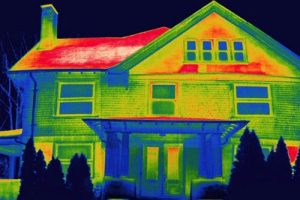 Like blood from a wound, your building could be leaking heat. When you turn the dial on your thermostat, you probably do not want your furnace to heat up the entire neighborhood. Yet, that’s exactly what happens when your home is under-insulated. Poor insulation can often be an expensive problem with cheap solutions. Proper attic insulation is crucial, as 25% of heat escapes through your attic during the fall and winter months. Insulation forms a barrier between your attic and the outside temperature. Following are some of the most common attic insulation problems.
Like blood from a wound, your building could be leaking heat. When you turn the dial on your thermostat, you probably do not want your furnace to heat up the entire neighborhood. Yet, that’s exactly what happens when your home is under-insulated. Poor insulation can often be an expensive problem with cheap solutions. Proper attic insulation is crucial, as 25% of heat escapes through your attic during the fall and winter months. Insulation forms a barrier between your attic and the outside temperature. Following are some of the most common attic insulation problems.
Do-It-Yourself Insulation
Gaps in the attic or between the lower floors and the attic will let heated (or cooled) air escape to the great, unconditioned outdoors, making any insulation you add essentially useless. Especially if you have uneven insulation material. Some homeowners choose to DIY their attic insulation. However, if the insulation material is not distributed properly, the R values will be higher in some parts and not in others and will let in more heat flow causing higher energy bills and poor temperature regulation. The solution is to leave this job to the professionals.
When Attic Insulation Deteriorates And Collapses
When attic insulation deteriorates and collapses, the R-value decreases. Insulation’s R-value refers to its ability to help your home retain heat in the winter and cool air in the summer. With a high R-value, your home stays comfortable throughout the year. As the R-value decreases, your house becomes less and less energy efficient. If you are using your attic for storage space, the boxes press against the insulation. The insulation becomes compressed and loses its ability to insulate. The best solution would be to keep heavy boxes and other bulky items off the insulation material. Install shelves for storage to relieve the weight from the attic insulation. Or, if it is possible, install flooring above the insulation so you can place items on the floor without directly putting weight on the insulation material below.
If You Have A Skylight, Insulate The Skylight Shaft
If the skylight shafts are installed in a vented, uninsulated attic, then the sides of the skylight shaft should be insulated. This can be accomplished using spray foam insulation. The best solution is to seal the insulation. Make sure to insulate around the shaft and seal it properly.
Insulate Access To Your Attic
If the attic access door is within the living space and can open directly into the attic it should be insulated. Whether in a hot or cold climate, the access door should be treated just like an outside entrance door; it must be insulated and weather-stripped. If you have a removable panel in your ceiling or a set of pull-down stairs to access the attic, the best solution would be to weatherstrip the trim and attach layers of foam board to the panel and install your choice of insulation on top. The R-value of the insulation of the access to the attic should be the same as that of the rest of your attic.
The Attic Is The Perfect Hideaway For Pests
Attics with inadequate insulation are attractive to pests. Pests thrive in places with excessive moisture. They also love insulation materials to build their nests. Watch out for birds, bats, mice, raccoons, cluster flies, and squirrels. The best solution would be to seal all the cracks, gaps, and holes. Make sure to replace the insulation material in these spots to restore thermal resistance in your attic. If you have an infestation, call your local extermination company to get rid of the pest. Then fix all the holes they might have made in the attic insulation.
Higher R-Value
A material’s insulation properties are rated as “R-value.” R stands for resistance. The higher the R-value, the greater the insulation. Each insulation material has a different R-value. The R-value also depends on the number of layers for multilayer attic insulation. If you have an inadequate R-value, the temperature in your home will not be properly regulated. The best solution is to have your attic’s insulation be a minimum of R-30 per the Department of Energy. The R-value depends on which climate zone you belong to. Zones 1 to 5, for example, require attic insulation of at least R-38 while the more northern zones 6-8 would need at least R-49 attic insulation.
What Are The 4 Types Of Attic Insulation?
- Fiberglass Batt Insulation
- Blown-In Fiberglass Insulation
- Blown-In Cellulose
- Spray Foam Insulation
Spray foam’s high R-value, air-tight seal, and ability to resist moisture make it the best overall option. Spray foam effectively reduces heating and cooling costs, saving you money on your utility bills.
Contact Us (513-771-3626) for More Information -or- Get a Quote!
—
 About Cincinnati RetroFoam
About Cincinnati RetroFoam
Cincinnati RetroFoam is an experienced insulation contractor providing injection foam, spray foam, and blown-in insulation services to the Cincinnati, Dayton, Northern Kentucky & South-East Indiana Areas. Cold Annoying Drafts? Outrageous Energy Bills? Improve Your Home with Insulation.
> Learn More

